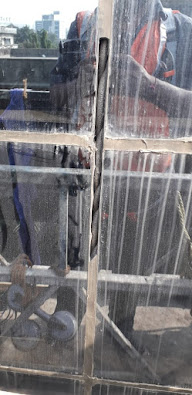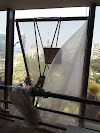How to Prevent Leakage from the Facade / Glass Exterior of Your Building?
Facade Maintenance work done for Larsen and Toubro by Landscape Wall Systems
Facade Maintenance
Facade Leakage Prevention
- Scope of Work:
The client has complaints about his existing Facade for Leakages. During the Rain, there was a high amount of accumulation of water inside the office from the Exterior. It was affecting the quality of Material stored in the Factory, wasting Packing Material since it was being wet.For the Client, it was difficult to identify the source/location of Water and water droplets.
- Facade Inspection: Identifying the Problem and its Location:
 |
| Pic 1: Sealant at Grooves between Two Glass Panels got removed, The Backer Rod is visible |
 |
| Pic 2: Absence of Sealant at Grooves between Two Glass Panels |
 |
| Pic 3: Sealant between Two Glass Panels is removed by Birds by their Peak |
- Facade Leakage Marking on Elevation drawings:
 |
| Facade Leakage Marking for Fresh Sealant Application |
The above drawing is typical, we made it for all Elevations.
- We carried out a Fresh Weather Sealant application Process to Carry out this Facade Maintenance Work.
Fresh Sealant application work includes:
- Removal of Existing Sealant with Knife and Wire Brush.
- Cleaning the grooves and Surface.
- Placing the masking Tape on the Cleaned surface at the Edges of the Grooves.
- Replace the Baker Rod if it is absent or torn.
- Placing a Weather Sealant ( e.g. DC789) to the required depth.
- Remove the excessive sealant and level it to the surface of the Facade.
- Remove the masking Taps and allow the weather sealant to dry.
- Facade after Completion of Fresh Sealant application Work:
 |
| Pic 4: Grooves and Joints after Fresh Weather Sealant Application between Glass Panels |
 |
| Pic 5: Grooves and Joints after Fresh Weather Sealant Application between Glass and ACP |
- Submission of Report on Drawings: Fresh Sealant application
 |
| Typical Drawing-Fresh Sealant Application at Grooves
For Records, we prepared such drawings and submitted a Complete Report where the Facade Sealant Work has been Carried Out.
|
Challenges:
1. Identifying the Quantity of required Weather Sealant since unless the Worker reaches the Top-level at every bay of Building Elevation it is difficult to estimate the required Quantity of Weather Sealant.
To continue the work without break we purchased excess material in advance.
2. Since the Quantity of Nozzles we get with Weather sealant is less, we had to clean the used nozzles frequently. Especially, when there was a holiday or if another work other than the Sealant application was being done by Workers.
3. In the case of installing a new Facade, Glasses are protected /covered. At this time the Facade was about to install. In facade Maintenance, when all Glass Panels are already installed, Glare and Heat from the Glasses affects the performance of workers working at Heigth in Cradle.
4. If all sealant from all grooves in one Elevation is allowed to be removed and replaced with Fresh Weather sealant it can be better since old sealant is hard and fresh sealant is viscous which does not create a good bond together.











0 Comments